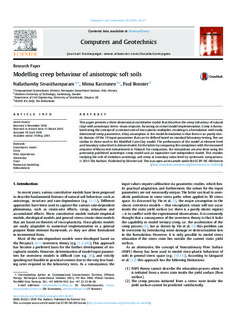| dc.contributor.author | Sivasithamparam, Nallathamby | |
| dc.contributor.author | Karstunen, Minna | |
| dc.contributor.author | Bonnier, Paul | |
| dc.date.accessioned | 2016-01-15T09:15:21Z | |
| dc.date.accessioned | 2016-01-25T10:06:24Z | |
| dc.date.available | 2016-01-15T09:15:21Z | |
| dc.date.available | 2016-01-25T10:06:24Z | |
| dc.date.issued | 2015 | |
| dc.identifier.citation | Computers and geotechnics 2015, 69:46-57 | |
| dc.identifier.issn | 0266-352X | |
| dc.identifier.uri | http://hdl.handle.net/11250/2374670 | |
| dc.description | - | |
| dc.description.abstract | This paper presents a three dimensional constitutive model that describes the creep behaviour of natural clays with anisotropic stress–strain response, focussing on robust model implementation. Creep is formulated using the concept of a constant rate of visco-plastic multiplier, resulting in a formulation with easily determined creep parameters. A key assumption in the model formulation is that there is no purely elastic domain. Of the 10 input parameters that can be defined based on standard laboratory testing, five are similar to those used in the Modified Cam-Clay model. The performance of the model at element level and boundary value level is demonstrated, for the latter by comparing the simulations with the measured response of Murro test embankment in Finland. For comparison, the simulations are also done using the previously published anisotropic creep model and an equivalent rate-independent model. This enables studying the role of evolution anisotropy and creep at boundary value level by systematic comparisons. | |
| dc.language.iso | eng | |
| dc.relation.uri | http://dx.doi.org/10.1016/j.compgeo.2015.04.015 | |
| dc.title | Modelling creep behaviour of anisotropic soft soils | |
| dc.type | Journal article | |
| dc.date.updated | 2016-01-15T09:15:21Z | |
| dc.identifier.doi | 10.1016/j.compgeo.2015.04.015 | |
| dc.identifier.cristin | 1243191 | |
